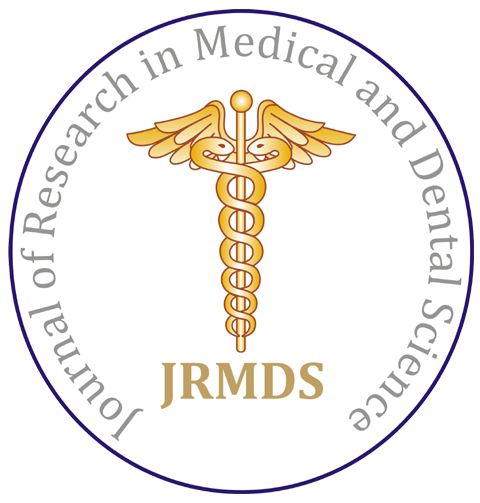Research - (2021) Volume 9, Issue 2
Knowledge Attitude and Practice of using Personal Protective Equipment among Lab Technicians
*Correspondence: Hannah R, Department of Oral and Maxillofacial Pathology, Saveetha Institution of Medical and Technical Sciences, India, Email:
Abstract
Personal protective equipment (PPE) should be used by all healthcare providers, Supporting staff, laboratory staff and their own family, who offer to care for the patients with infections or communicable diseases. Contact with blood, body fluids, nasal discharge and droplets make them more prone for disease transmission. The Risks can be minimized by use of PPE if properly selected and worn by workers creating a safe and healthy workplace. The aim of the study is to determine the knowledge, attitude and practice of using Personal protective equipment among lab technicians. A cross sectional survey was conducted among 50 laboratory technicians. Self - administered questionnaires were designed based on knowledge attitude and practice. The questions were distributed through the google forms. Responses were then tabulated and statistically analyzed. 79.2% of the population had 1-10 years of experience. 92.5% of the population says they follow the steps that were recommended by WHO for performing hand hygiene regularly.90.6% of the population say that a mask is personal protective equipment. We can conclude that although the knowledge regarding PPE is good among Lab technicians they need to be advised to use it appropriately in order to protect themselves and in turn protect their families.
Keywords
Laboratory technicians, Personal protection equipment, PPE, Covid-19.
Introduction
Increase in contagious disease like Covid-19, SARS, MERS, Ebola, H1N1 etc. has led to the increasing need for the use of personal protective equipment (PPE) among all health care workers. Healthcare workers including Doctors, healthcare workers, Nurses, Lab technicians etc. are more prone to get infected either directly or indirectly. Personal Protective equipment is like a shield which protects them. It obstructs the portal of entry of microbes at some stage in communication with such vicious fluids [1]. Pandemic and reappearing illnesses are positioned to increase need for personal protective equipment for all healthcare workers [2] There Inadequate resource and knowledge regarding the utilization of personal protective equipment (PPE). Improper PPE use, long working hours in the face of a shortage of medical personnel and transmission outside the patient care setting are possible explanations for the reasons to get infected [3]. PPE must be put on correctly or else the person may be uncomfortable to wear it and also proper removal protocol should be followed otherwise the healthcare workers may contaminate themselves when they remove it [4]. Some PPE has been adapted, for example, by adding extra tabs to grab so it will be easier to remove. Guidelines on the correct procedure for wearing and removing PPE are available from several organizations such as Centre for disease control (CDC) [5]. To elevate the safety of PPE, the quality of PPE and its wear ability should not be compromised [6]. Personal protective equipment if properly selected and worn by health care workers will create a safe and healthy workplace which is very crucial especially in today's scenario of Covid 19 pandemic [7].
The personal protective equipment consists of gloves, protecting eye wear, mask, apron, gown, boots/shoes, hair cover. Face shields such as nose masks, safety glasses, and safety google protect the face and eyes. work shoes with shoe cover and puncture resistant soles protect the foot, hard hats protect the head and face, earplug protects the ears, and hand gloves of the right size protects the hand [8] Often more than one of her PPE's are worn at same time in worker place depending on the work exposure [9]. A health worker may need face mask, gloves and gown depending on the activity being carried out and the need for these PPES have increased over years with increased communicable diseases [10]. PPE Should be used by all healthcare providers, supporting staff and own family, who offer to care for patients in conditions where there is contact with blood, fluid, secretions or excretion [11]. Contamination of the skin, hair and clothing of healthcare workers during removal of personal protective equipment contributes to dissemination of pathogens and is at a high risk for infection [12]. Most present studies have centered on either publicity to infectious disease and its consciousness [10]. Personal protective equipment is readily available and widely recommended among health care workers [9]. Handling blood and body fluids of patients with infectious diseases places laboratory technicians at high risk [13]. These infections may lead to increased mortality. Methods to prevent infection among lab technicians include hand hygiene, isolation of patients etc... [14]. This study will focus on the mindset and practice of utilization of PPE among lab technicians who are at high risk. Different surveys indicate that PPE is often not worn by lab technicians and the evidence also suggests that this can cause much harm. Many studies have been undertaken based on oral and general health care [15]. Our University has done many survey topics which inspired us also to do a survey [16-21]. There are also some review topic done on oral cancer and other oral diseases [22-24]. Many of the studies involved technological advancements [25-30]. The idea of current survey stemmed from the current interest of the community. The aim this study is to determine the Knowledge, attitude and Practice of using Personal protective equipment among lab technicians.
Materials and Method
This is a cross sectional descriptive Survey that was conducted among 50 laboratory technicians of the age group 18-50 years. Convenience sampling was done. The study was approved by the scientific review board. This survey consists of 18 self-administered questions which were validated and then circulated using Google forms. Data was exported to SPSS and data analysis done using chi square. Demographic information, knowledge, Attitude and Practice of using PPE were the output variables. The data collected was tabulated using excelling sheets and then appropriate statistics was done using SPSS software. Age, gender, was considered as the independent variables whereas knowledge, Attitude, Practice of using PPE were the dependent variables.
Results and Discussion
The results of the study have shown that 79% of the participants were female and 21% were males. When the participants were asked about their work experience in the laboratory 79.2% had 1-10 years’ experience and 18.9% had work experience about 11-20 years and 1.9% had work experience about 21-30 years. When the participants were asked if they know what PPE stands in order to assess their level of knowledge regarding PPE 84:9% of the population said personal protective equipment 9.4% say Personal protective education 2:5% said private protective equipment. 3.2 % said Primary protective education. When the response was associated with the years of experience, Chi square test analysis showed no statistical significance P=0.838 (P>0.05). When the participants were asked if the mask is a PPE 90.6% of the population agreed (Figure 5). On questioning the participants about whether training was required wear and remove PPE 60.4% of the population said. When the participants were asked which one is not a PEE 18.97 of the population said Slip on 41.5% said cap 11.3% said Gloves and 28.3% said Goggles.
On assessing the attitude of the participants towards use of PPE, 83.6% were aware that PPE protects them from infections caused by HBV, HIV and coronavirus (SARS, Covid 19 etc.) while 13 .2% were not. When the participants were asked if the gloves hinder their working skills 64.2% of the population agreed and 35.4% Say No. When the participants were asked if PPE was a fool protection from all infections only 28.3 % of the population said yes the rest did not agree. In the practice aspect, When the participants were asked How often do they replace their PPE 26.4% of the population said Once in 6 hours, 43.4% said Once in weeks, 20.8% said once in 6 month and 9.4 % said never. When the participants were asked what they would do when they find it uncomfortable to wear the PPE 52.8%. The population said that they remove it immediately, 37.7% said they would bear the discomfort. 9.4% said they would never use PPE again. When the participants were asked if they wear PPE regularly 83% of the population said yes. When the participants were asked if they follow the steps that were recommended by WHO for performing hand hygiene regularly 92.5% of the population said Yes and 7.5% said No. Only 24.5% of the participants wear eye protection (Figure 1 to Figure 25).
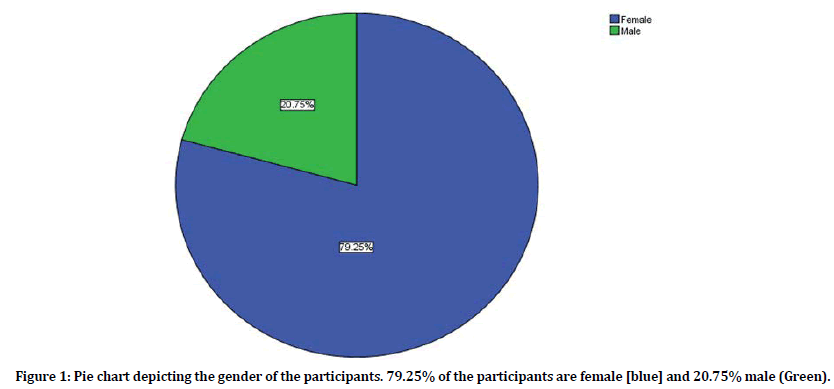
Figure 1. Pie chart depicting the gender of the participants. 79.25% of the participants are female [blue] and 20.75% male (Green).
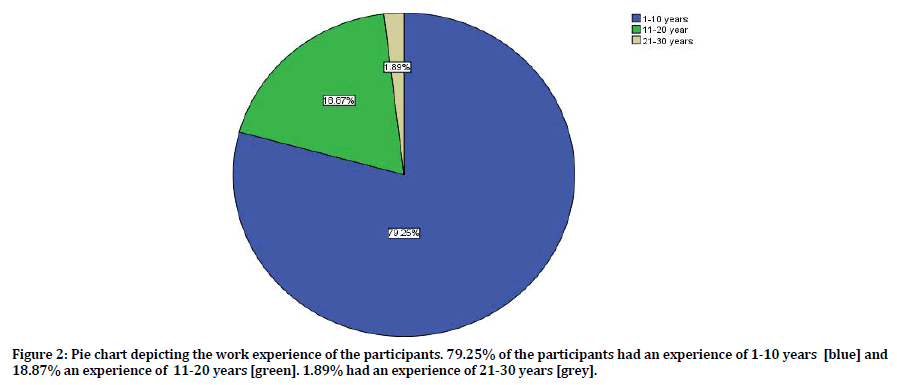
Figure 2. Pie chart depicting the work experience of the participants. 79.25% of the participants had an experience of 1-10 years [blue] and 18.87% an experience of 11-20 years [green]. 1.89% had an experience of 21-30 years [grey].
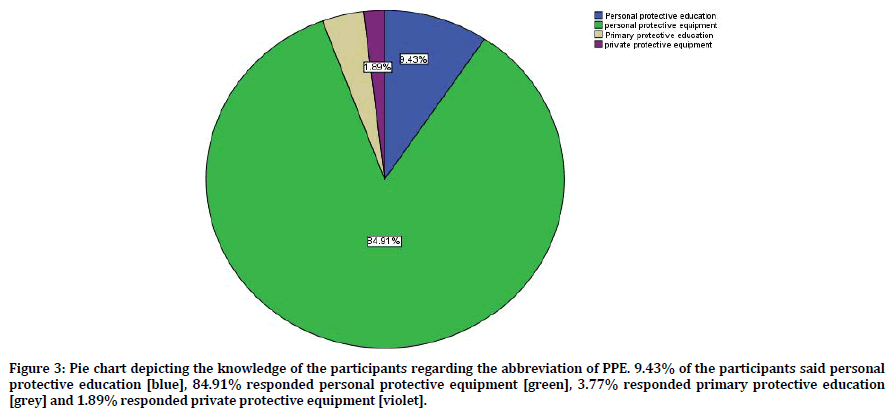
Figure 3. Pie chart depicting the knowledge of the participants regarding the abbreviation of PPE. 9.43% of the participants said personal protective education [blue], 84.91% responded personal protective equipment [green], 3.77% responded primary protective education [grey] and 1.89% responded private protective equipment [violet].
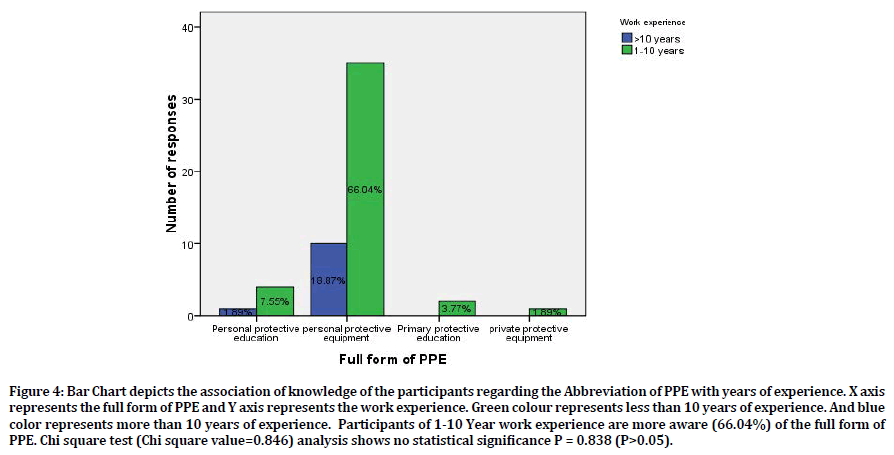
Figure 4. Bar Chart depicts the association of knowledge of the participants regarding the Abbreviation of PPE with years of experience. X axis represents the full form of PPE and Y axis represents the work experience. Green colour represents less than 10 years of experience. And blue color represents more than 10 years of experience. Participants of 1-10 Year work experience are more aware (66.04%) of the full form of PPE. Chi square test (Chi square value=0.846) analysis shows no statistical significance P = 0.838 (P>0.05).
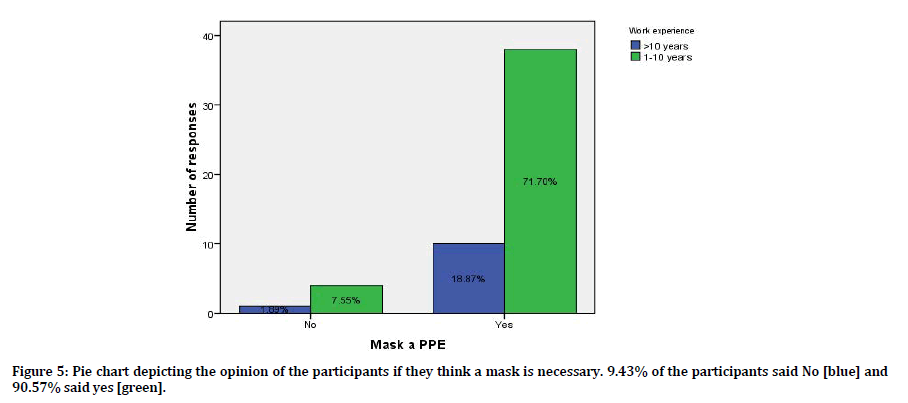
Figure 5. Pie chart depicting the opinion of the participants if they think a mask is necessary. 9.43% of the participants said No [blue] and 90.57% said yes [green].
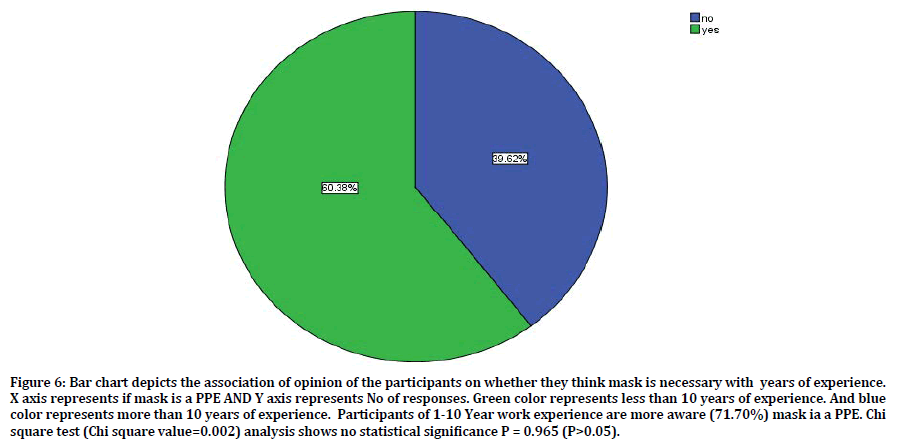
Figure 6. Bar chart depicts the association of opinion of the participants on whether they think mask is necessary with years of experience. X axis represents if mask is a PPE AND Y axis represents No of responses. Green color represents less than 10 years of experience. And blue color represents more than 10 years of experience. Participants of 1-10 Year work experience are more aware (71.70%) mask ia a PPE. Chi square test (Chi square value=0.002) analysis shows no statistical significance P = 0.965 (P>0.05).
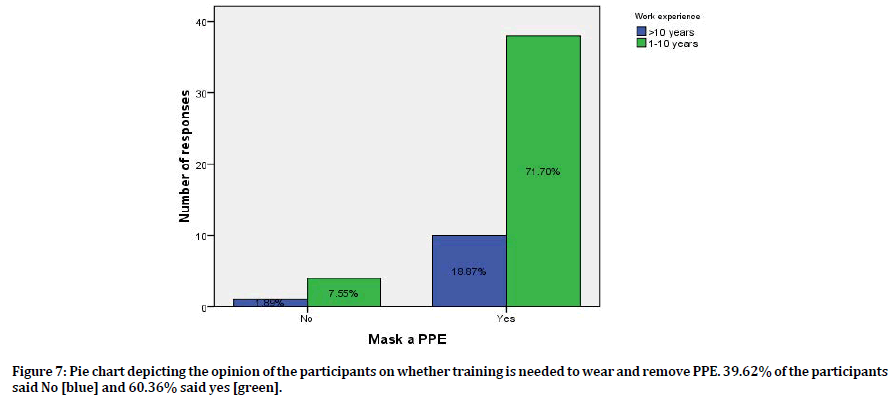
Figure 7. Pie chart depicting the opinion of the participants on whether training is needed to wear and remove PPE. 39.62% of the participants said No [blue] and 60.36% said yes [green].
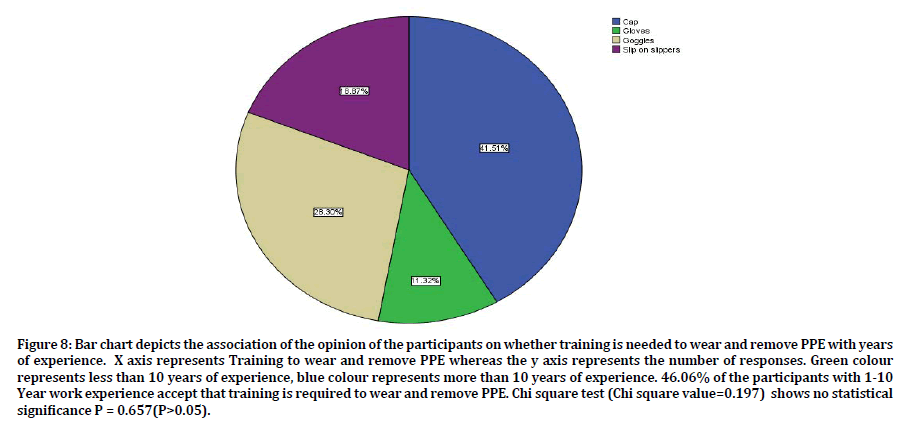
Figure 8. Bar chart depicts the association of the opinion of the participants on whether training is needed to wear and remove PPE with years of experience. X axis represents Training to wear and remove PPE whereas the y axis represents the number of responses. Green colour represents less than 10 years of experience, blue colour represents more than 10 years of experience. 46.06% of the participants with 1-10 Year work experience accept that training is required to wear and remove PPE. Chi square test (Chi square value=0.197) shows no statistical significance P = 0.657(P>0.05).
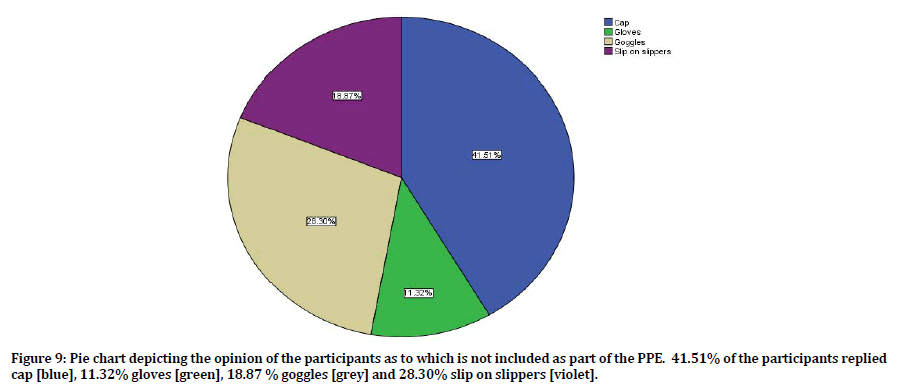
Figure 9. Pie chart depicting the opinion of the participants as to which is not included as part of the PPE. 41.51% of the participants replied cap [blue], 11.32% gloves [green], 18.87 % goggles [grey] and 28.30% slip on slippers [violet].
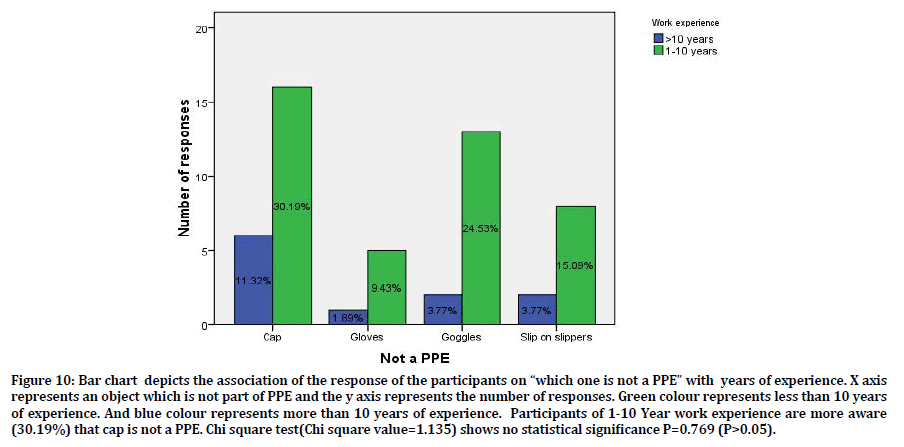
Figure 10. Bar chart depicts the association of the response of the participants on “which one is not a PPE” with years of experience. X axis represents an object which is not part of PPE and the y axis represents the number of responses. Green colour represents less than 10 years of experience. And blue colour represents more than 10 years of experience. Participants of 1-10 Year work experience are more aware (30.19%) that cap is not a PPE. Chi square test(Chi square value=1.135) shows no statistical significance P=0.769 (P>0.05).
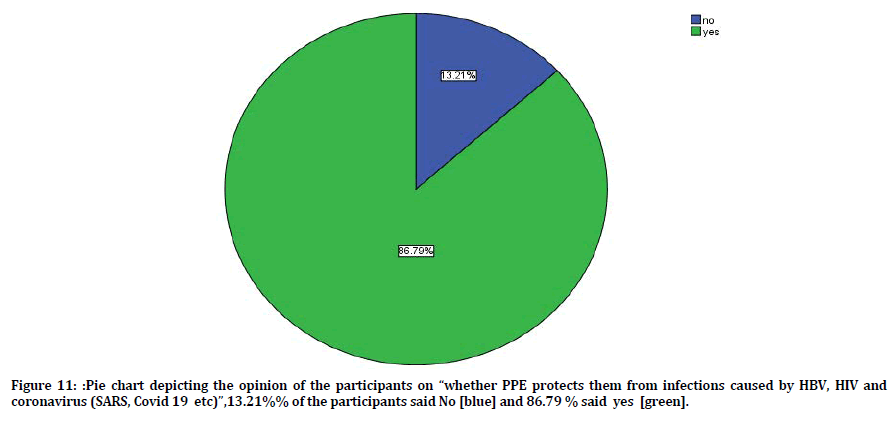
Figure 11. Pie chart depicting the opinion of the participants on “whether PPE protects them from infections caused by HBV, HIV and coronavirus (SARS, Covid 19 etc)”,13.21%% of the participants said No [blue] and 86.79 % said yes [green].
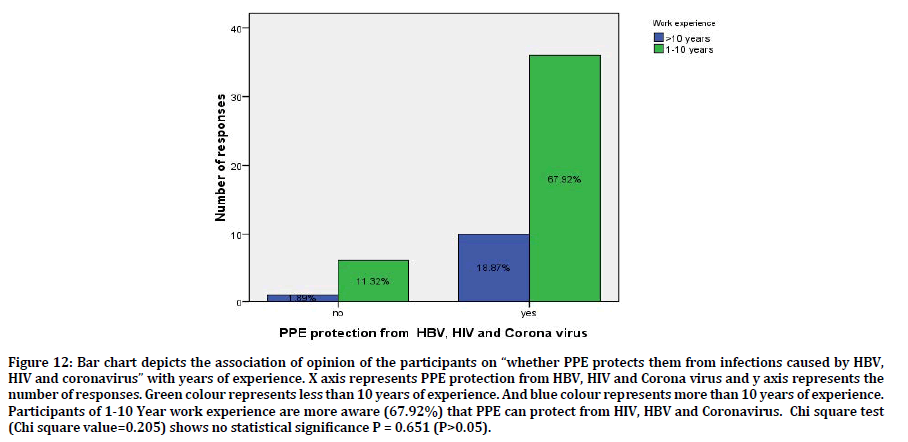
Figure 12. Bar chart depicts the association of opinion of the participants on “whether PPE protects them from infections caused by HBV, HIV and coronavirus” with years of experience. X axis represents PPE protection from HBV, HIV and Corona virus and y axis represents the number of responses. Green colour represents less than 10 years of experience. And blue colour represents more than 10 years of experience. Participants of 1-10 Year work experience are more aware (67.92%) that PPE can protect from HIV, HBV and Coronavirus. Chi square test (Chi square value=0.205) shows no statistical significance P = 0.651 (P>0.05).
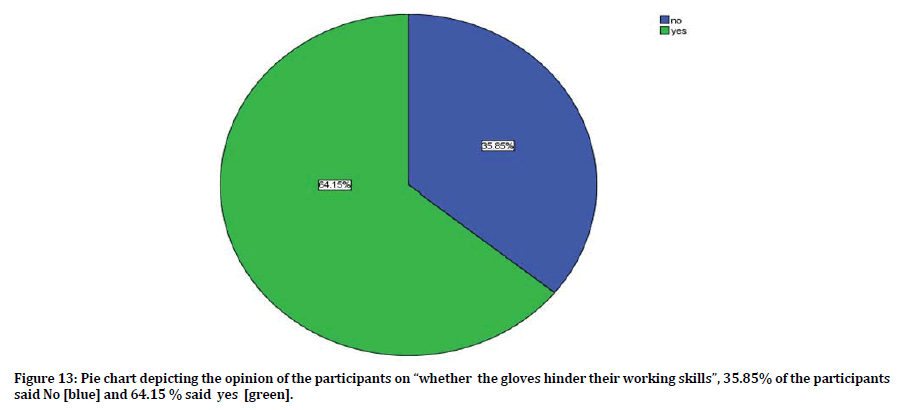
Figure 13. Pie chart depicting the opinion of the participants on “whether the gloves hinder their working skills”, 35.85% of the participants said No [blue] and 64.15 % said yes [green].
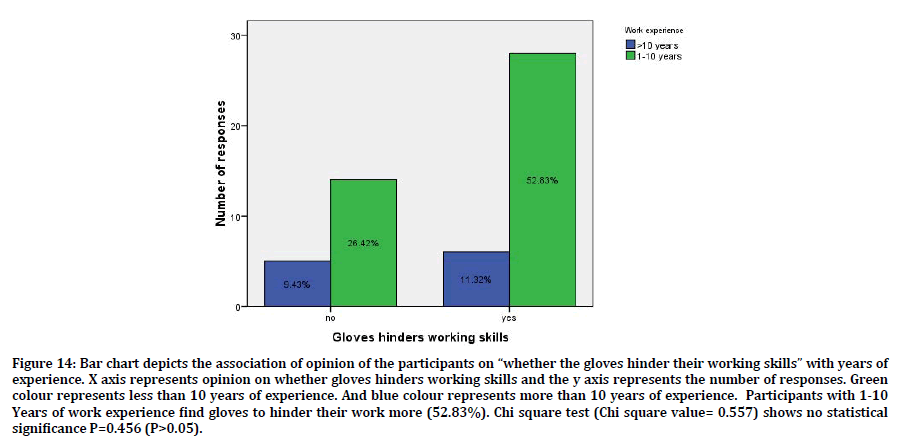
Figure 14. Bar chart depicts the association of opinion of the participants on “whether the gloves hinder their working skills” with years of experience. X axis represents opinion on whether gloves hinders working skills and the y axis represents the number of responses. Green colour represents less than 10 years of experience. And blue colour represents more than 10 years of experience. Participants with 1-10 Years of work experience find gloves to hinder their work more (52.83%). Chi square test (Chi square value= 0.557) shows no statistical significance P=0.456 (P>0.05).
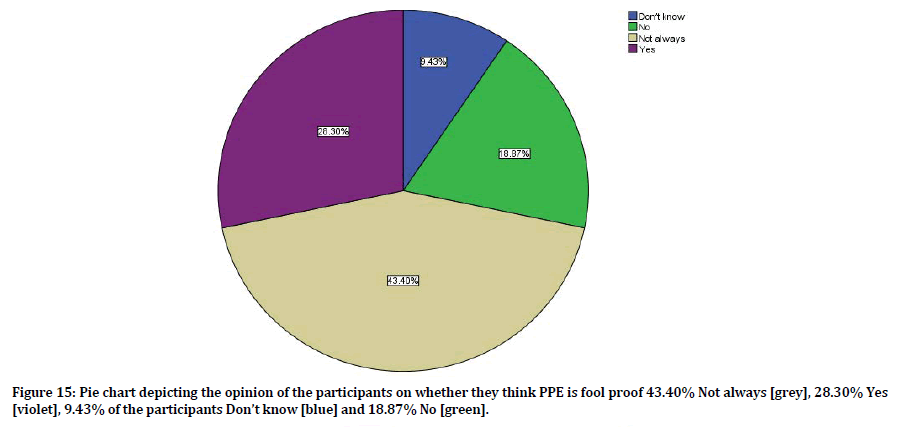
Figure 15. Pie chart depicting the opinion of the participants on whether they think PPE is fool proof 43.40% Not always [grey], 28.30% Yes [violet], 9.43% of the participants Don’t know [blue] and 18.87% No [green].
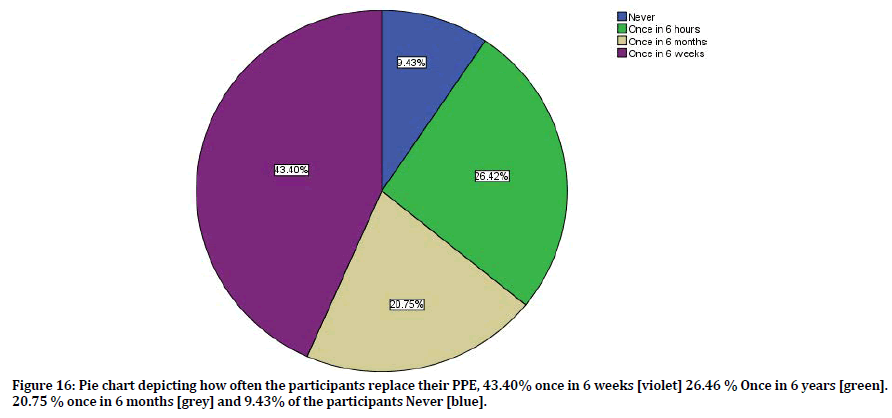
Figure 16. Pie chart depicting how often the participants replace their PPE, 43.40% once in 6 weeks [violet] 26.46 % Once in 6 years [green]. 20.75 % once in 6 months [grey] and 9.43% of the participants Never [blue].
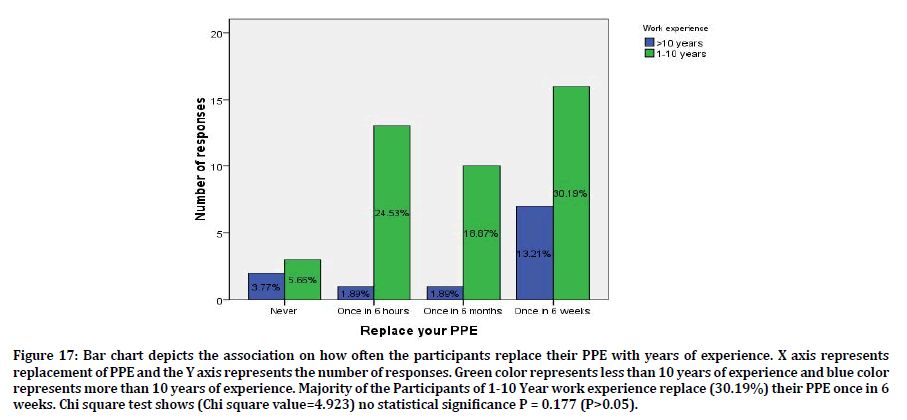
Figure 17. Bar chart depicts the association on how often the participants replace their PPE with years of experience. X axis represents replacement of PPE and the Y axis represents the number of responses. Green color represents less than 10 years of experience and blue color represents more than 10 years of experience. Majority of the Participants of 1-10 Year work experience replace (30.19%) their PPE once in 6 weeks. Chi square test shows (Chi square value=4.923) no statistical significance P = 0.177 (P>0.05).
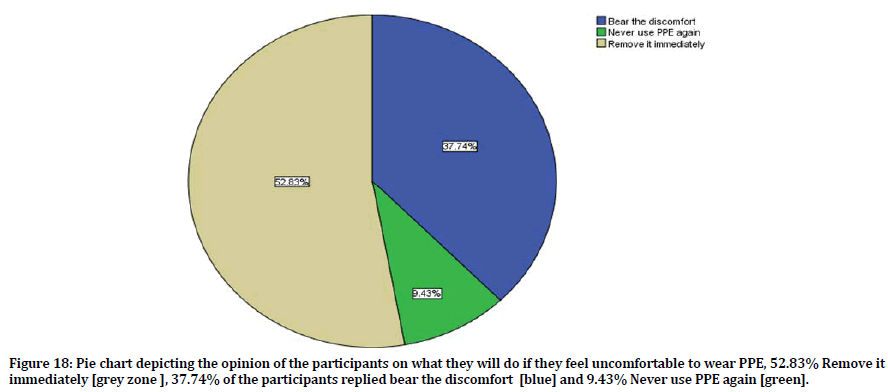
Figure 18. Pie chart depicting the opinion of the participants on what they will do if they feel uncomfortable to wear PPE, 52.83% Remove it immediately [grey zone ], 37.74% of the participants replied bear the discomfort [blue] and 9.43% Never use PPE again [green].
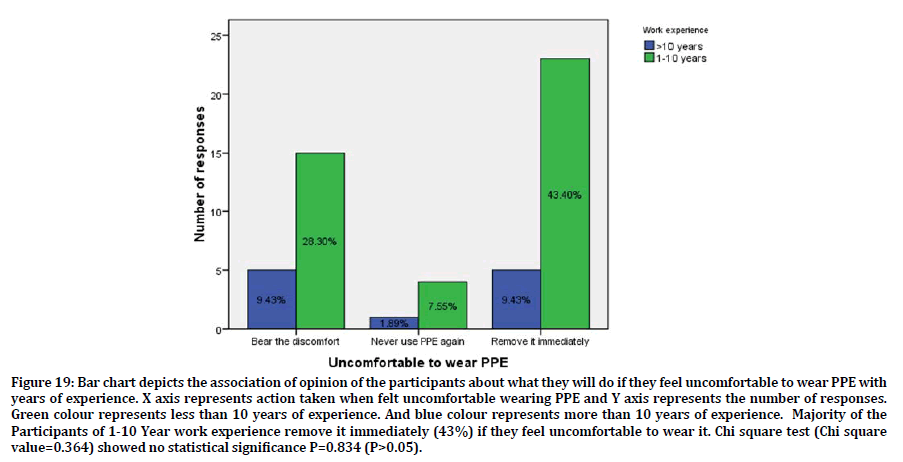
Figure 19. Bar chart depicts the association of opinion of the participants about what they will do if they feel uncomfortable to wear PPE with years of experience. X axis represents action taken when felt uncomfortable wearing PPE and Y axis represents the number of responses. Green colour represents less than 10 years of experience. And blue colour represents more than 10 years of experience. Majority of the Participants of 1-10 Year work experience remove it immediately (43%) if they feel uncomfortable to wear it. Chi square test (Chi square value=0.364) showed no statistical significance P=0.834 (P>0.05).
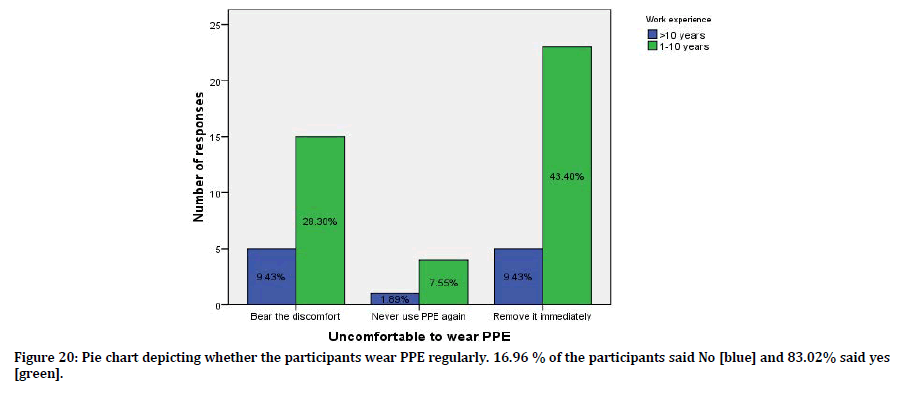
Figure 20. Pie chart depicting whether the participants wear PPE regularly. 16.96 % of the participants said No [blue] and 83.02% said yes [green].
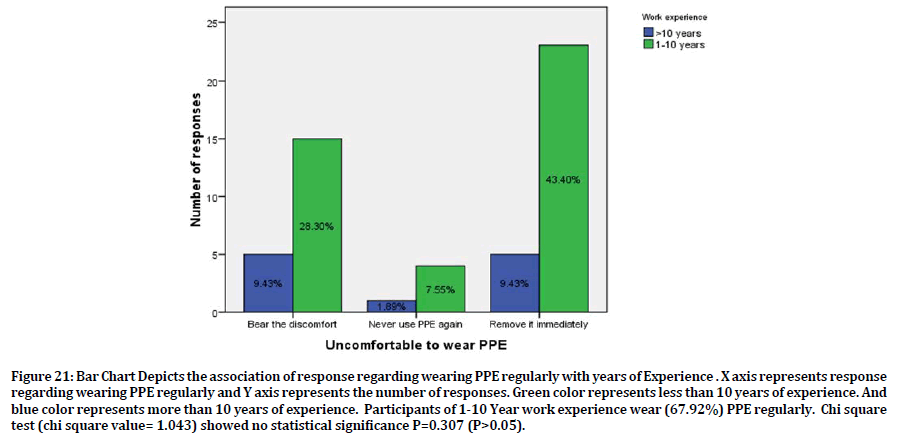
Figure 21. Bar Chart Depicts the association of response regarding wearing PPE regularly with years of Experience . X axis represents response regarding wearing PPE regularly and Y axis represents the number of responses. Green color represents less than 10 years of experience. And blue color represents more than 10 years of experience. Participants of 1-10 Year work experience wear (67.92%) PPE regularly. Chi square test (chi square value= 1.043) showed no statistical significance P=0.307 (P>0.05).
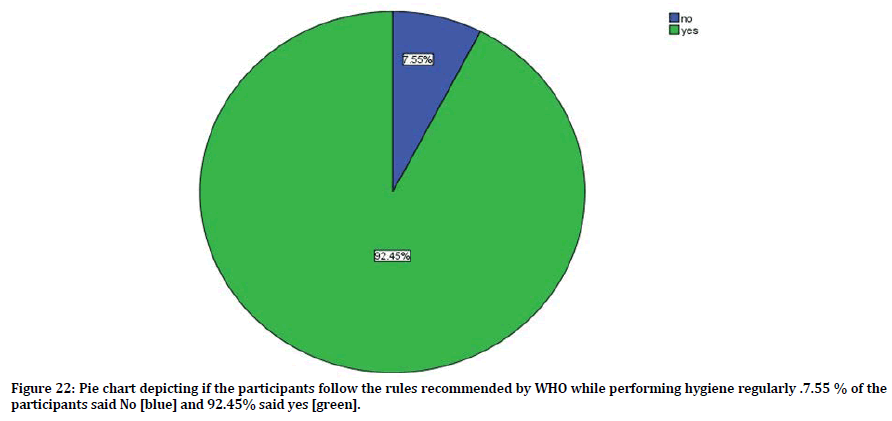
Figure 22. Pie chart depicting if the participants follow the rules recommended by WHO while performing hygiene regularly .7.55 % of the participants said No [blue] and 92.45% said yes [green].
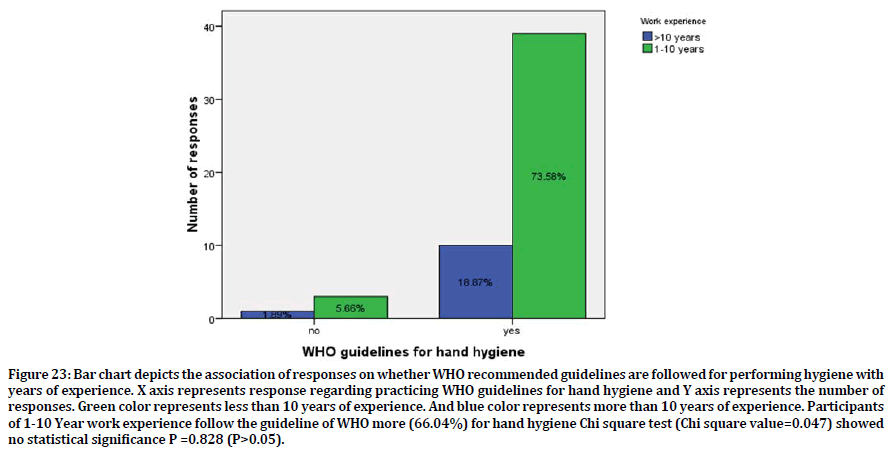
Figure 23. Bar chart depicts the association of responses on whether WHO recommended guidelines are followed for performing hygiene with years of experience. X axis represents response regarding practicing WHO guidelines for hand hygiene and Y axis represents the number of responses. Green color represents less than 10 years of experience. And blue color represents more than 10 years of experience. Participants of 1-10 Year work experience follow the guideline of WHO more (66.04%) for hand hygiene Chi square test (Chi square value=0.047) showed no statistical significance P =0.828 (P>0.05).
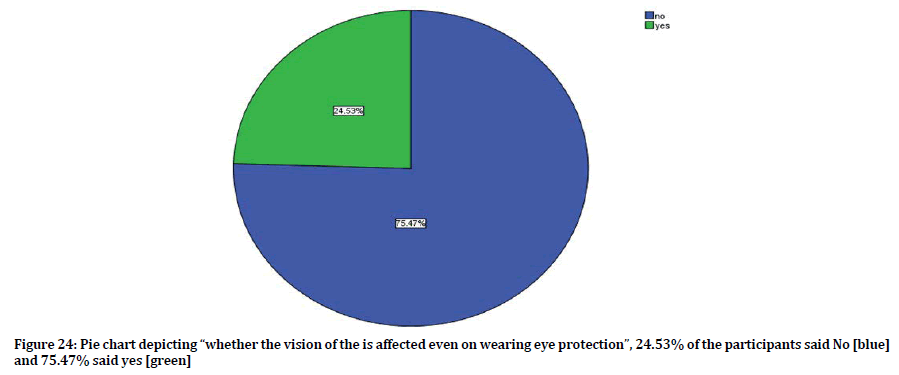
Figure 24. Pie chart depicting “whether the vision of the is affected even on wearing eye protection”, 24.53% of the participants said No [blue] and 75.47% said yes [green]
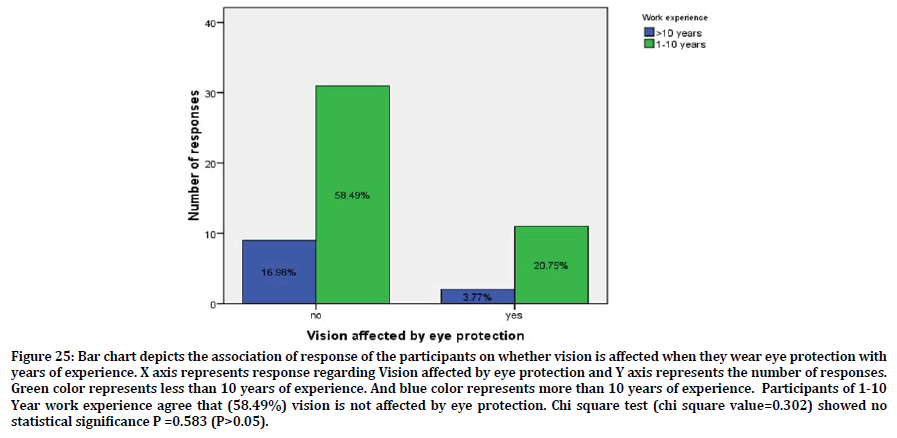
Figure 25. Bar chart depicts the association of response of the participants on whether vision is affected when they wear eye protection with years of experience. X axis represents response regarding Vision affected by eye protection and Y axis represents the number of responses. Green color represents less than 10 years of experience. And blue color represents more than 10 years of experience. Participants of 1-10 Year work experience agree that (58.49%) vision is not affected by eye protection. Chi square test (chi square value=0.302) showed no statistical significance P =0.583 (P>0.05).
In our study most of the participants knew the expansion of PPE and were aware that the mask was part of it. But in a study done by Bulkhyur et al. only 56% knew about PPE. The large Variation between our study and the study done by Bulkhyur et al. is because their study was carried out among workers and ours were lab technicians. The workers mostly use helmets and boots so they are not much aware of Mask and PPE [10]. Although awareness about PPE was very less previously, there has been a sudden increase in awareness because of the Covid pandemic.
Most of the study participants were aware that PEE protects from infections that are caused by HBV, HIV, covid19 etc. In regular situations PPE was used only when laboratory confirmed patients with any of these infections arrive, this is in accordance with the study done by Archana Lakshmi et al. among Healthcare workers where PPE was used only when a patient tested positive for HIV comes to the hospital [2]. More than half of the participants confirm the need for training to wear and remove a PPE. But in a study done by TS Oguntonis et al. among funeral home workers most of them disagreed [1]. The wide variation in data is because the current study was conducted in the pretext of Covid 19. The global pandemic has created awareness regarding PPEs and the need for training to wear and remove it.
Gloves are considered a hindrance by more than half of the laboratory technicians who had taken the survey. But Archana Lakshmi et al. in their study found that most of them did not find it as a hindrance. Although gloves can be a hindrance in the beginning it is important for the laboratory technicians to use it judiciously in order to protect themselves and in turn protect their family too [2]. The study participants also resorted to the fact that they would remove the PPE as and when they find it uncomfortable. But in today's scenario all healthcare workers including the laboratory technicians are at a high risk zone and hence should guard themselves from being infected despite the discomfort [2].
In Our Study the Sample size of the Study is very less and the population is done only in lab Technicians. It is also done in a homogenous population which may mislead. The future scope of this study is to do a complete survey based study on the uses Of PPE among Doctors and Nurses in a larger population and in a larger scale.
Conclusion
Within the limitations of the study we can conclude that Lab technicians have good knowledge and awareness about personal protective equipment. Although the knowledge regarding PPE is good they need to be advised to use it appropriately in order to protect themselves and in turn protect their families. More awareness programs and training on correct ways of handling PPE will help them to use it effectively.
References
- Oguntona TS, Adedeji OO, Ogunsola D, et al. Awareness and use of personal protective equipment (PPE) and practice of safety precautions among funeral home workers in Lagos State. Transitional J Sci Tech 2010; 2:47–53.
- Lakshmi G, Meriton SA, Christina MP, et al. A study on personal protective equipment use among health care providers, Tamil Nadu. Inter J Com Med Public Health 2016; 5.
- Hersi M, Stevens A, Quach P, et al. Effectiveness of personal protective equipment for healthcare workers caring for patients with filovirus disease: A rapid review. PLoS One 2015; 10:e0140290.
- Loibner M, Hagauer S, Schwantzer G, et al. Limiting factors for wearing personal protective equipment (PPE) in a health care environment evaluated in a randomised study. PLoS One 2019; 22:14:e0210775.
- Verbeek JH, Rajamaki B, Ijaz S, et al. Personal protective equipment for preventing highly infectious diseases due to exposure to contaminated body fluids in healthcare staff. Cochrane Database Syst Rev 2020; 5:CD011621.
- Akbar-Khanzadeh F, Bisesi MS, Rivas RD, et al. Comfort of personal protective equipment. Appl Ergon 1995; 26:195–198.
- Muema LM. evaluation of personal protective equipment utilization among construction workers in mombasa county, Kenya. COHES, JKUAT 2017.
- Izudi J, Ninsiima V, Alege JB, et al. Use of personal protective equipment among building construction workers in Kampala, Uganda. J Environ Public Health 2017; 23:7930589.
- Carpenter WS, Lee BC, Gunderson PD, et al. Assessment of personal protective equipment use among Midwestern farmers. Am J Ind Med 2002; 42:236–247.
- Balkhyour MA, Ahmad I, Rehan M. Assessment of personal protective equipment use and occupational exposures in small industries in Jeddah: Health implications for workers. Saudi J Biol Sci 2019; 26:653–659.
- Aguwa EN. A review of Sir thomas legge’s aphorisms and workplace personal protective equipments--Is there gap in knowledge, attitude and utilization. Occup Med Health Aff 2013; 1:2.
- Tomas ME, Kundrapu S, Thota P, et al. Contamination of health care personnel during removal of personal protective equipment. JAMA Intern Med 2015; 175:1904–1910.
- Aguwa EN, Arinze-Onyia SU, Ndu A, et al. Use of personal protective equipment among health workers in a tertiary health institution, South East Nigeria: Pre-Ebola Period. Int J Health Sci Res 2016; 6:12–18.
- Casanova L, Alfano-Sobsey E, Rutala WA, et al. Virus transfer from personal protective equipment to healthcare employees’ skin and clothing. Emerg Infect Dis 2008; 14:1291–1293.
- Tanko BL, Anigbogu NA. The use of personal protective equipment (PPE) on construction sites in Nigeria. In: Laryea, S, Agyepong, SA, Leiringer R, et al. Proceedings of 4th West Africa built environment research (WABER) Conference, 2012; 24-26.
- Palati S, Ramani P, Shrelin HJ, et al. Knowledge, attitude and practice survey on the perspective of oral lesions and dental health in geriatric patients residing in old age homes. Indian J Dent Res 2020; 31:22–25.
- Uma PK, Ramani P, Sherlin HJ, et al. Knowledge about legal aspects of medical negligence in india among dentists--A questionnaire survey. Medico Legal Update 2020; 20:111–115.
- Krishnan RP, Ramani P, Sherlin HJ, et al. Surgical specimen handover from operation theater to laboratory: A survey. Ann Maxillofac Surg 2018; 8:234–238.
- Hannah R, Ramani P, Sherlin HJ, et al. Awareness about the use, ethics and scope of dental photography among undergraduate dental students dentist behind the lens. Res J PharmTech 2018; 11:1012–1016.
- Harrita S, Santhanam A. Determination of physical height using clinical crown height of deciduous teeth. Indian J Forensic Med Toxicol 2019; 13:23–27.
- Padavala S, Sukumaran G. Molar incisor hypomineralization and its prevalence. Contemp Clin Dent 2018; S246–250.
- Hema Shree K, Ramani P, Sherlin H, et al. Saliva as a diagnostic tool in oral squamous cell carcinoma: A systematic review with meta-analysis. Pathol Oncol Res 2019; 25:447–453.
- Sarbeen JI, Gheena S. Microbial variation in climatic change and its effect on human health. Research. J Pharma Tech 2016; 9:1777–1781.
- Manohar J, Abilasha R. A study on the knowledge of causes and prevalance of pigmentation of gingiva among dental students. Indian J Public Health Res Develop 2019; 10:95–100.
- Guru PE, Gheena S. A study of empathy across students from 4 health disciplines among 1st years and final years. Research J Pharm Tech 2016; 9:1472.
- Abitha T, Santhanam A. Correlation between bizygomatic and maxillary central incisor width for gender identification. Br Dent Sci 2019; 22:458–466.
- Palati S, Ramani P, Sherlin HJ, et al. Age estimation of an individual using olze’s method in Indian population-A cross-sectional study. Indian J Forensic Med Toxicol 2019; 13:121–124.
- Gunasekaran G, Abilasha R. Tooth sensitivity among residential university students in chennai. Asian J Pharma Clini Res 2016; 63.
- Ahad M, Gheena S. Awareness, attitude and knowledge about evidence based dentistry among the dental practitioner in Chennai city. Res J Pharm Tech 2016; 9:1863–1866.
- Sheriff K, Santhanam A. Knowledge and awareness towards oral biopsy among students of saveetha dental college. Res Pharm Tech 2018; 11:543–546.
Author Info
Department of Oral and Maxillofacial Pathology, Saveetha Institution of Medical and Technical Sciences, IndiaCitation: Lekha, Hannah R, The Knowledge Attitude and Practice of using Personal Protective Equipment among Lab Technicians, J Res Med Dent Sci, 2021, 9 (2):370-382.
Received: 29-Sep-2020 Accepted: 22-Feb-2021
